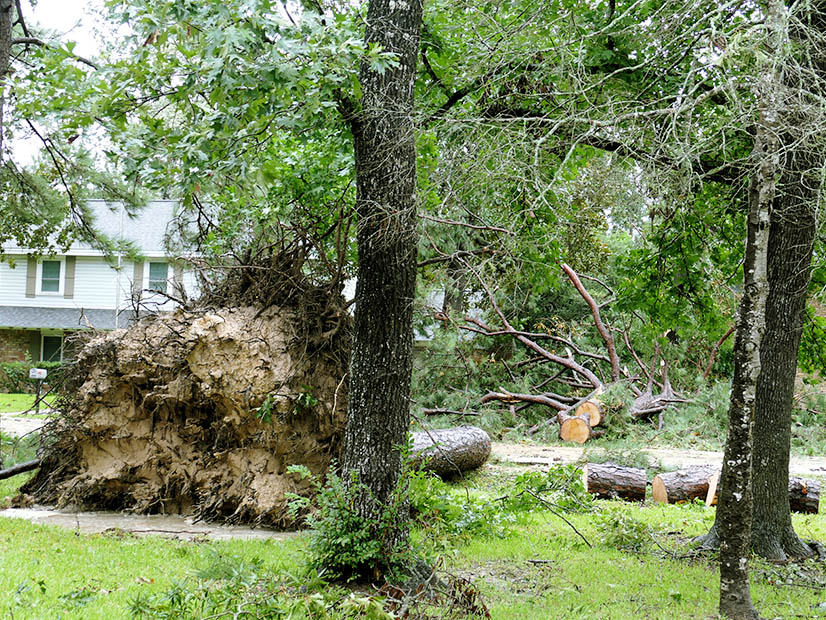
Transmission providers told Texas regulators July 11 that Hurricane Beryl’s high winds deep inland in a heavily wooded region led to significant customer outages that will last more than a week after the storm’s landfall.
Representatives from four of the state’s primary wires carriers told the Public Utility Commission during an open meeting that more than 1.4 million customers were still without power in the Houston area. That is down from the nearly 3 million outages when Beryl came ashore July 8.
Entergy Texas CEO Eli Viamontes, who began his utility career at Florida Power and Light, said he was caught off-guard by wind speeds that exceeded 80 mph more than 70 miles from the Gulf Coast.
“I’ve seen many storms in my career, coming from South Florida, and the sustained winds keeping up that far inland was surprising,” he said. “You combine that fact with the most densely populated area of our service territory, that also happens to be one of the most densely vegetated areas as well, you literally have that perfect combination that has caused the [outage] numbers to certainly seem higher given a Category 1, but the damage is real.”
Entergy lost seven of eight major transmission ties in its footprint, and 385 poles, 195 transformers and 34 substations. It peaked at 252,000 customer outages July 8 but reduced that number to just over 101,000 on July 11.
Commissioner Jimmy Glotfelty, a Houston native, got a personal view of some of the destruction the day after the storm hit when he visited a CenterPoint Energy staging site.
“I think what was astonishing in Houston was the number of large trees that were pulled up by the root ball as opposed to broken at the top,” he said. “It was just pretty amazing. These aren’t ones that just require chainsaws. You have to have cranes to get them out of the road, so it’s kind of a different kind of storm, from my perspective.”
Jason Ryan, an executive vice president with CenterPoint, said an 83-mph wind gust at George Bush Intercontinental Airport, 20 miles north of downtown Houston, was greater than the wind speeds measured during Hurricane Ike in 2008. A Category 2 storm, Ike caused an estimated $30 billion in damage in Texas and other states.
“I’ll set aside whether it was a Category 1, 2, 3 or 4 hurricane,” Ryan said of Beryl. “It was a significant hurricane as it came ashore and as it left our system midday.”
The CenterPoint executive said the storm’s path was “one of the worst paths a hurricane could take.” The greater Houston area was on Beryl’s “dirty side” east of the eyewall with the strongest winds and severest weather as it swirled from right to left, he said.
“The wind speeds were higher further inland,” Ryan said, noting the National Weather Service issued 67 tornado watches as it pushed inland.
The level of destruction has slowed the damage assessment the utilities conduct before beginning restoration work. Ryan said CenterPoint expected to complete its damage assessment July 11. He said the company had already restored about 1.2 million homes and businesses as of July 10, leaving a little over 1 million to go. About 80% of the restoration will be completed July 14, with about 500,000 outages beginning a second week without power.
“We need to know what kind of crews to send where. That’s what our damage assessment workers do in the early days after a storm,” Ryan said. “If I have substantial damage to distribution poles, if I’ve got poles on the ground, I need to send a construction crew. If I have trees on lines, I need to send vegetation management crews to go in and clear those trees. If I can quickly restore service by doing minor work on facilities, I can send much smaller crews out to do that. We can’t start sending crews out until we get that damage assessment done.”
CenterPoint has borne the brunt of criticism leveled over restoration service as temperatures rise and, with it, the stress on residents sitting in long lines for gasoline or in crowded restaurants.
Houston Mayor John Whitmire has said the utility “needs to do a better job.” U.S. Rep. Sylvia Garcia (D-Texas) went to social media to tell CenterPoint, “Your failure during this crisis is unacceptable.”
Also on social media, one wag pointed out the Whataburger fast-food chain’s app is a better outage tracker than CenterPoint’s.
Texas Gov. Greg Abbott, who is on an economic development trip in East Asia, called for an investigation into the “multiple occasions” the Houston region has suffered through a major outage. In May, a derecho’s 100-mph winds knocked 922,000 CenterPoint customers offline, some for more than two weeks; the utility has estimated it will cost $475 million in repair work.
PUC Chair Thomas Gleeson said he has had discussions with the governor’s office and Lt. Gov. Dan Patrick and that “we’re going to figure this out.” He said the commission plans to file a report before the January 2025 legislative session with learnings from its review and “potentially some legislative solutions that we may need.”
“I want to assure everybody this will be the first step in this process, not the last step,” he said.
The PUC was a receptive audience for Entergy, CenterPoint, AEP Texas and Texas-New Mexico Power. The commissioners did not offer critiques of their performance but provided suggestions for better communications with their communities.
The utilities have either provided resilience plans to the PUC or will soon, a result of recent legislation.


